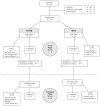Medication and parent training in children with pervasive developmental disorders and serious behavior problems: results from a randomized clinical trial
- PMID: 19858761
- PMCID: PMC3142923
- DOI: 10.1097/CHI.0b013e3181bfd669
Medication and parent training in children with pervasive developmental disorders and serious behavior problems: results from a randomized clinical trial
Erratum in
- J Am Acad Child Adolesc Psychiatry. 2010 Jul;49(7):727
Abstract
Objective: Many children with pervasive developmental disorders (PDDs) have serious, functionally impairing behavioral problems. We tested whether combined treatment (COMB) with risperidone and parent training (PT) in behavior management is superior to medication alone (MED) in improving severe behavioral problems in children with PDDs.
Method: This 24-week, three-site, randomized, parallel-groups clinical trial enrolled 124 children, aged 4 through 13 years, with PDDs, accompanied by frequent tantrums, self-injury, and aggression. The children were randomized 3:2 to COMB (n = 75) or MED (n = 49). The participants received risperidone monotherapy from 0.5 to 3.5 mg/day (with switch to aripiprazole if risperidone was ineffective). Parents in the COMB group (n = 75; 60.5%) received a mean of 10.9 PT sessions. The primary measure of compliance was the Home Situations Questionnaire (HSQ) score.
Results: Primary: intent-to-treat random effects regression showed that COMB was superior to MED on HSQ (p = .006) [effect size at week 24 (d) = 0.34]. The HSQ score declined from 4.31 (± 1.67) to 1.23 (± 1.36) for COMB compared with 4.16 (± 1.47) to 1.68 (± 1.36) for MED. Secondary: groups did not differ on Clinical Global Impressions-Improvement scores at endpoint; compared with MED, COMB showed significant reductions on Aberrant Behavior Checklist Irritability (d = 0.48; p = .01), Stereotypic Behavior (d = 0.23; p = .04), and Hyperactivity/Noncompliance subscales (d = 0.55; p = .04). Final risperidone mean dose for MED was 2.26 mg/day (0.071 mg/kg), compared with 1.98 mg/day for COMB (0.066 mg/kg) (p = .04).
Conclusions: Medication plus PT resulted in greater reduction of serious maladaptive behavior than MED in children with PDDs, with a lower risperidone dose.
Trial registration: ClinicalTrials.gov NCT00080145.
References
-
- American Psychiatric Association. Diagnostic and Statistical Manual of mental Disorders. 4. Washington DC: American Psychiatric Association; 2000. Text Revision.
-
- Lecavalier L. Behavioral and emotional problems in young people with pervasive developmental disorders: Relative prevalence, effects of subject characteristics, and empirical classification. J Autism Dev Disord. 2006;36:1101–1114. - PubMed
-
- Gadow KD, DeVincent CJ, Pomeroy J, Azizian A. Comparison of DSM-IV symptoms in elementary school-aged children with PDD versus clinic and community samples. Autism. 2005;9:392–415. - PubMed
-
- Tonge BJ, Einfeld SL. Psychopathology and intellectual disability: The Australian Child to Adult Longitudinal Study. In: Glidden LM, editor. International Review of Research in Mental Retardation. Vol. 26. San Diego: Academic Press; 2003. pp. 61–91.
-
- Williams SK, Scahill L, Vitiello B, Aman MG, Arnold LE, McDougle CJ, McCracken JT, Tierney E, Ritz L, Posey DJ, Swiezy NB, Hollway J, Cronin P, Ghuman J, Wheeler C, Cicchetti D, Sparrow S. Risperidone and adaptive behavior in children with autism. J Am Acad Child Adolesc Psychiatry. 2006;45:431–439. - PubMed



